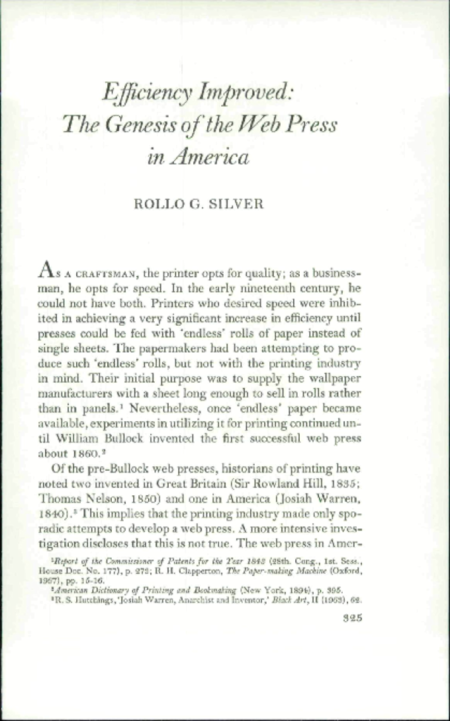The American web press developed gradually through the work of several men whose work has not been adequately recognized. In 1817, Thomas Gilpin began operating his machine, which made paper in rolls rather than in sheets, in Delaware. In 1819, Joshua and Thomas Gilpin began printing on "endless" paper. Henry Betts (1794-1880) of Norwalk, Connecticut, received a patent in 1833 for "printing paper on both sides." Shortly after, a papermaker from Ithaca, New York, Thomas Trench (1808-97), built a web press for printing books. Josiah Warren constructed another web press, for printing newspapers. With an 1843 British patent, Moses S. Beach (1822-92) built a web press in Rhode Island, but Jeptha A. Wilkinson (1791-1873), who received a U.S. patent for a similar press in 1853, was apparently the original inventor of that press. Wilkinson devised a type-revolving press seven years before the more publicized, similar press of Richard M. Hoe appeared. In 1851, Thomas H. Dodge (1832-1910) of New Hampshire invented a web press mainly for job printing, as did George P. Gordon (1810-78) in 1852. In 1853, Charles Montague (1820-85) patented an "Improved Printing-Press for Printing on a Continuous Sheet." Henry A. Bills and Stephen W. Wood of Washington, D.C., acquired a patent in 1858 for a type-revolving web press for printing newspapers, while a similar patent went to Joseph H. Smith and Lloyd M. Orvis in Wisconsin in 1860. A press for printing railroad "through tickets" for connecting railroads was patented by George Bailey in 1860. All these presses were for book, newspaper, or job printing, and actually represented only one kind of web press. 4 illus., 58 notes.
Efficiency Improved: The Genesis of the Web Press in America.
Publication Date
Volume
80
Part
2
Page Range
325-350
Proceedings Genre
